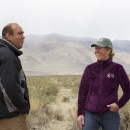States
West VirginiaThe Partners for Fish and Wildlife program provides technical and financial assistance to private landowners to restore and enhance fish and wildlife habitat on their property. The program’s focus is to restore habitat to benefit federally listed and at-risk species.
Who's Eligible?
Technical assistance is available to all landowners. Financial assistance can not be spent on federal or state lands but all other landowners qualify, including private landowners, county/city municipalities, corporations, businesses, private organizations educational institutions, and conservation organizations.
What Types of Projects are Funded?
Cropland, pasture, wetland, upland, or stream habitats which have been previously drained or altered are all potential project sites. Partner projects are typically designed to restore fish and wildlife habitat to historic conditions. Plans may include:
Planting trees to restore upland habitat
Removal of barriers to fish passage fish passage
Fish passage is the ability of fish or other aquatic species to move freely throughout their life to find food, reproduce, and complete their natural migration cycles. Millions of barriers to fish passage across the country are fragmenting habitat and leading to species declines. The U.S. Fish and Wildlife Service's National Fish Passage Program is working to reconnect watersheds to benefit both wildlife and people.
Learn more about fish passage , including culverts, dams, and other in-stream structuresEnhancement and restoration of instream habitat
Protecting and/or restoring riparian riparian
Definition of riparian habitat or riparian areas.
Learn more about riparian areasWetland enhancement/restoration
Installation of livestock exclusion fencing along streams
Installation of cave gates to restrict access and protect associated fauna and flora
Conservation Education Outreach/Outdoor Classrooms
Invasive species control
How does the Program work?
Landowners interested in habitat restoration should contact us to discuss potential opportunities and schedule a site visit. A biologist will contact you to schedule a visit to determine if your site is suitable for restoration. If your property is identified as a beneficial project site, you could:
Receive financial assistance to implement habitat enhancements/restoration
Receive financial and/or technical assistance from other groups (state agencies, conservation districts, other Federal programs)
Financial or in-kind contribution from the landowner is not mandatory but will aid in project selection. Preference will be given to projects that leverage cost-share from the landowner and other potential partners. Most importantly, landowners do not forfeit property rights and control all activities such as hunting, fishing, camping and trespass.



